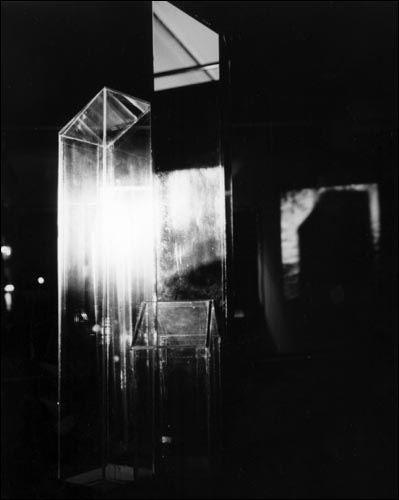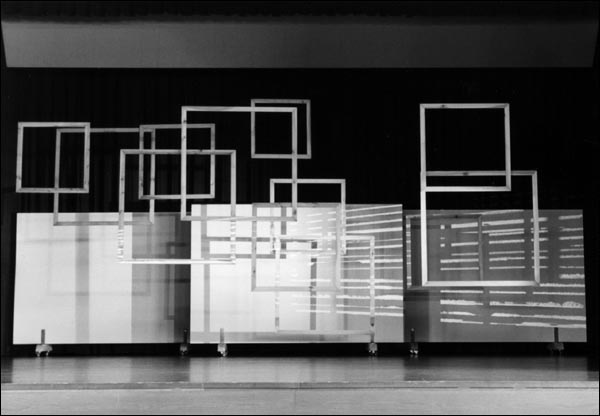BETWEEN
10.12.1999 - 7.01.2000
"Pejzaże świetlne", zapisy drogi: Frankfurt - Kassel, 1981
"Pejzaże świetlne", zapisy drogi: Frankfurt - Kassel, 1981
LIGHT, SPACE AND TIME IN THE ART OF ANTONI MIKOŁAJCZYK
Among the works of Antoni Mikołajczyk, created by means of various techniques and artistic technologies - from painting to installations and light projections through photography, film and video - one can point out a clearly visible line that joins them all and makes for a single, coherent phenomenon. Mikołajczyk's art is characterized by an exceptional coherence of the problems he undertakes as well as by his creative consistency. These problems are connected with basic questions referring to visual art: the question of the relation of a work to the real world, the relation of the object to its image, the place and function of light or spatial and temporal relations. This strong interest in the material reality of an artwork is not the result of those trends in 20th century art which strived to erase the dividing line between the matter of art and the real world and everyday reality - like pop-art, new realism or Fluxus. Mikołajczyk tries to preserve the autonomy of an artwork and art as opposed to life and everyday reality. He composes his message at the border between the two entities. The evolution of his art leads to a cleaner and more direct use of light in an artwork, light which is the most fundamental form of matter in visual arts. It is the process of "liberating light". It is accompanied by the gradual reduction of form and the purification of the work - whatever it might be - by means of removing all unnecessary elements from it: not in order to concoct the most pure art form of all, as in minimal art, but in order to present the questions discussed by the author in a most direct and clear way. Experiments with painting, photography, film and video, conducted in the 60s in such artistic groups as Zero-61, Krąg or Pętla, and later continued in the next decade at the Łódź Workshop of Film Form, made the author concentrate on the problem of light, space and time. The experiments with various forms of imagery were necessary in order to clear the field for future research, to move from registering and analyzing images of the real world in photography, film or video ("Rejestracja totalna / Total Registration", 1974, photograph; "Opis przestrzeni / Description of Space", 1979, video installation, performance) to light registrations which did not copy images any more, but the structure of the world and the spatial and temporal relations that can be found in it (his first "Zapisy / Registrations" of 1979 and "Partytury miast / Partiturs of Cities", 1980). The next step in liberating light conceived as the matter of a work - light installations, projections or performances - was the direct result of "Registrations" and Partiturs of Cities", and to some degree marked the reversal of the situations presented in them. Light, which used to be the instrument directly describing spatio-temporal structures became the element that constituted the work itself and its spatiality. This move introduced new phenomena and new problems - materiality and the dematerialization of the work-object, and the problem of reality and illusion connected with its perception, as well as the sphere and the scale of work's realization, which included real space and materiality. Starting with registrations and light installations, light, liberated from the function of reproducing reality, becomes in itself a reality, taking on creative, almost subjective features. "Light Registrations" or Partiturs of Cities" introduce interesting questions, connected with photography as well as the relations of light to space and time. They are based on registering traces, emitted by a moving light source. Camera time is set to "B" position. The opening of the shutter lasts long, for about an hour, while the camera and the artist move both in space and time (the first registration of this type is "Light Waves in Space. The Registration of the Road Kassel - Fulda", 1982). The photographic film registered mainly traces of certain points, shining brightly at night - like street lights or car lights - in the form of a complicated net of overlapping, continuous lines. The space in which the objects and the camera move, and the time in which it happens become condensed in those unique pictures. They do not render real space in a flat picture, according to the rules of geometrical perspective, as the case is in normal photography. The trace of a real, moving object draws lines directly within the photographic image, grasping both the changing spatial relations as well as the passing time. Thus the complex line structure, created in this way, is not the photographic reproduction of reality but a copy of the structure of spatio-temporal relations in the real world. Those light registrations introduce another interesting aspect connected directly with the person of the author. In mechanical imagery, in photography, film or video, we usually do not perceive the direct relation between the artist and the image, which may be clearly observed in an image created manually. The manual image is the direct trace of the movement of the artist's hand, elongated by means of a brush, pencil or an etching-needle. In a photographic image we do not perceive this "elongation" of the artist's body and its bodily traces. At best we treat it as an "elongation" of the photographing eye or as the proof of his presence in some concrete "here and now". Those registrations go beyond this specific proof of being and present the relations between the author, his body and the image in a different way. Mikołajczyk, who moves along with the camera in hand and the shutter open at time "B", influences directly what the camera registers. Movements of his body, the facts of where and how he moves in space influences the single image, registered while the shutter is open. This creates completely new and unexpected relations in photography, relations between the picture and the author as a person. The image becomes a much richer "trace" of his presence with regard both to time and to space, it takes on a psychological or even an existential dimension. The experiences and reflections resulting from those light registrations, having to do with the nature of spatio-temporal relations and the part the light plays in grasping them, led Antoni Mikołajczyk to the next step of his research - to light installations. Light was used in them directly, as one of the most important elements of the work and the basis of its form. They are of a twofold character. The first of those installations are flat light projections on three-dimensional, spatial ready-made forms or forms especially created for this purpose. The projection of a set of lines or planes onto the surface of three-dimensional pictures changes their spatiality, creating the illusion of new spatial relations. The other kind of installation is based on creating light planes and light spaces which complete the solid figure of large, three-dimensional forms, like pyramids or cuboids. One of the planes marking the border between the object and the space surrounding it is open. The "internal light" of the object, its "light space", escapes through the opening to the outside. Depending on the direction of radiation, light completes an object with a missing side plane - when it hits the object from the side - or it seems to lift the object upwards, when it is directed upwards, from below the open plane at the bottom. In both cases the light creates new spatial divisions. Those installations curiously reveal the nature of space, its indeterminacy and immateriality by means of the equally indeterminate and immaterial light. It turns out that light can very suggestively mediate in the "materialization" of space whose nature forever remains mysterious and unclear for us, because it is invisible and immaterial. Light does it much more effectively than real, physically perceivable spatial forms. Light registrations and light installations are linked by one more important element: the kind of light which is the creative factor in light registrations and which becomes matter in the installations. In both cases we have to do mainly with radiated or emitted light, not with reflected light as in other more or less traditional visual works - except video works where the light of the image is emitted from the monitor screen. Emitted light is more dynamic and active, which shows both in "Registrations", where it draws complex structures of lines-traces, and in light installations which it helps to create. Changes resulting from such use of light may refer to the environment of the work which seizes the planes or objects closest to it by means of projection or reflection, or to the material objectivity of its particular elements. The changes in light installations lead also to other fascinating effects. On the one hand light which completes the object makes it immaterial and strips it of some of its physical features (like weight, when the light seems to lift the object) or a clearly determined border-line between the object and the surrounding space. On the other hand light planes and spaces "materialize" light, making it and its performance visible. It is the physical role of light to make the world visible, but it is also the metaphoric role of art. Antoni Mikołajczyk has exceptional predecessors in 20th century art. However, his achievements are closest to the theoretical concepts and practice of László Moholy-Nagy with his idea of "Lichtgestaltung", of light shaping, which leads to a total artwork (Gesamtkunstwerk), to pure projections in space, to the light liberated from all other functions. But there is a difference between the two artists, not only because several artistic generations separate them, but also because they differed as to the aim of their consistent artistic practice. Moholy-Nagy tried to concoct absolute form in its purest form, based on the most basic element of visual art, the light, without forgetting the practical possibilities of conducting laboratory experiments, both in art and outside it. Mikołajczyk, on the other hand, based his works on the direct influence of light, leaving its trace within the image (light registrations), or creating new situations in real space (light installations), which presented the audiences with works that were new visual experiences. Mikołajczyk makes the audience reflect, not only on the essence of the works which reveal unexpected functions and relations of light, but also on questions of more general nature. Such reflections concern the nature of our own relations towards space and time, and towards our participation in this "invisible" and "immaterial" light, which we are normally unaware of. Every-day experience shows that time, space and light may not be experienced directly. We only "feel" them due to the effects they cause or due to the lack of such effects. Mikołajczyk's art survived the pressure of fashions and fads of the art market. It also survived the shakedown or even breakdown of the criteria and values of the function of art and its awareness in modern civilization and culture. Antoni Mikołajczyk is faithful to himself and consistent in following his programme. He is one of those exceptional contemporary artists who still believe in art and its irreplaceable, metaphysical function of a mediator between the material and the ideal world, between the individual experience of the artist and the individual experience of the perceiver. He strives to explain or perhaps just touch the problems and fundamental questions which face everyone willing and able to reflect on himself and the world.
November 1999, Lech Lechowicz
translated by Maciej Świerkocki
"Zapisy dźwięku", Warszawa, 1998
z cyklu: "Partytury miast" - Dilsberg, 1998
Świetlna instalacja ruchoma, Galeria FF, Łódź, 1998
Instalacja "Pusty kwadrat", Oberkirch, 1999
Exhibition: "Between"
Exhibition: "Between"
Exhibition: "Between"
Exhibition: "Between"
Copyright ©1999 Antoni Mikołajczyk, Lech Lechowicz, Galeria FF ŁDK










